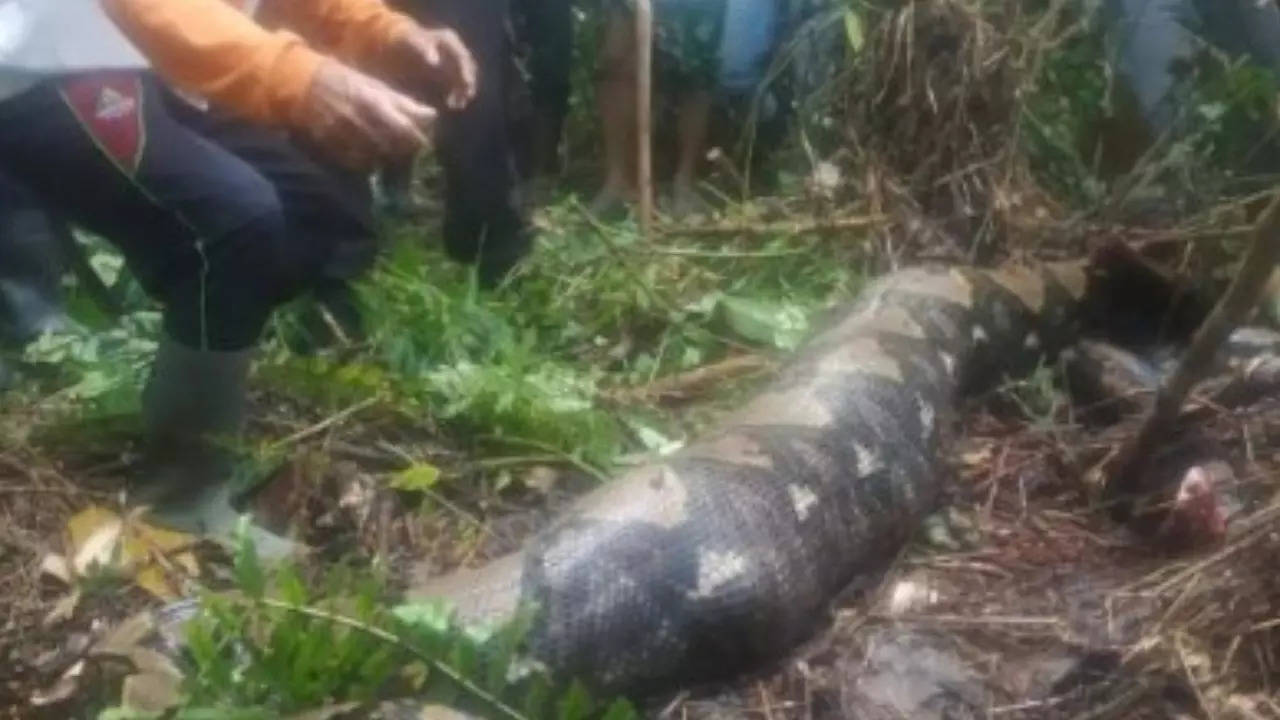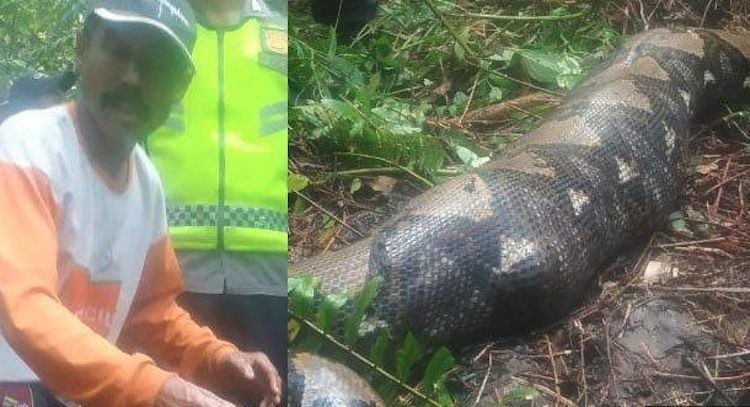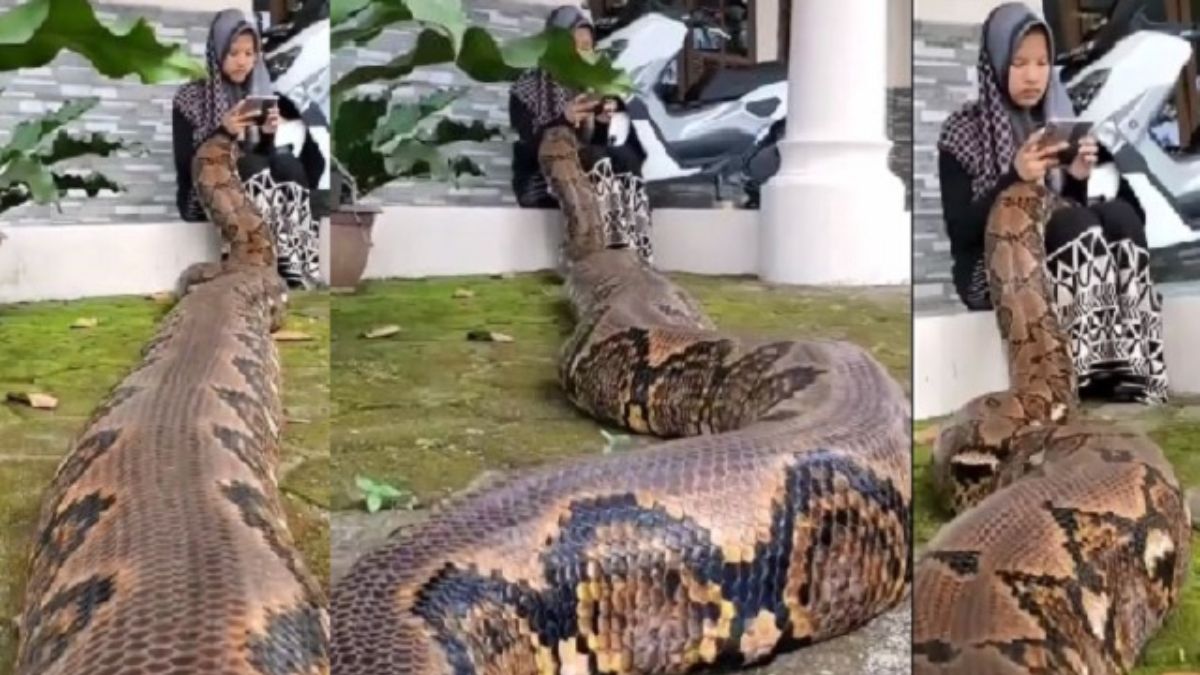PP2. What they uncovered was beyond their wildest imagination—a woman wrapped inside the belly of the beast...
In recent weeks, social media platforms have been flooded with viral posts claiming that a woman was found alive inside a massive snake in a Southeast Asian jungle. While the dramatic story quickly gained millions of views and shares, wildlife experts and fact-checking organizations have since raised serious concerns about its accuracy and the danger of spreading sensationalized misinformation about animals and indigenous regions.
The story—which initially surfaced on social media networks like TikTok, Facebook, and YouTube—described a group of hikers allegedly discovering an “unusually large snake” in a remote jungle. According to the viral content, the group found a living woman inside the snake's body, claiming she had been abducted and later miraculously survived within the reptile.
However, no reputable news organization or governmental wildlife authority has confirmed such an event. The lack of verifiable sources, forensic evidence, or official rescue records has led wildlife biologists, journalists, and public safety officials to label the incident as likely fabricated or heavily exaggerated.
What Experts Say: No Scientific Evidence Supports the Viral Claims
Organizations like National Geographic, Snopes, and the International Union for Conservation of Nature (IUCN) have analyzed similar viral animal stories over the years and caution the public against accepting extraordinary claims without official documentation.
“There is no scientifically credible case of a human being found alive inside a snake,” said Dr. Amanda Green, a herpetologist with the Smithsonian National Museum of Natural History, in a statement to Reuters. “These kinds of stories often rely on fictional embellishment and can fuel unwarranted fear and hostility toward native wildlife.”
Large constrictor snakes such as pythons and anacondas are capable of consuming animals much larger than themselves, including deer, pigs, and, on very rare and tragic occasions, humans. However, the idea of someone surviving inside such an animal for an extended period without oxygen, severe internal injury, or digestion is biologically implausible.

Real Incidents vs. Fabrication: The Danger of Viral Misinformation
The widespread sharing of the viral snake story highlights a troubling trend: the blending of myth and digital storytelling that can mislead audiences and overshadow genuine wildlife conservation efforts.
According to a report from Poynter Institute’s MediaWise project, misleading or fabricated wildlife stories can:
- Harm conservation efforts by encouraging fear instead of education.
- Distract from real cases of endangered species in crisis.
- Undermine scientific literacy and trust in factual journalism.
In Southeast Asia, where this viral story was claimed to have occurred, countries like Indonesia, Malaysia, and Thailand have made significant efforts to preserve reptile habitats and manage human-wildlife conflict through national parks and protected areas. Spreading misinformation can counteract years of environmental education and collaboration between local communities and conservation authorities.

The Psychology Behind Viral Animal Stories
Why do such stories capture the public imagination so quickly?
Experts in digital media and psychology say viral stories involving wild animals often leverage deep-rooted human emotions—such as awe, fear, or wonder—and sensational language to drive clicks, shares, and engagement.
“Stories that contain improbable survival tales or dangerous wildlife encounters tend to go viral because they tap into primal fears and curiosity,” said Dr. Tanya Boyd, a professor of digital media at UCLA. “But it’s essential to fact-check such claims before they’re shared, as false information can spiral quickly and shape public perception.”
How to Verify Wildlife News
For those wanting to stay informed without falling for misleading content, here are a few tips from the International Fact-Checking Network (IFCN) and the World Wildlife Fund (WWF):
- Check the source: Is the story reported by verified media such as BBC News, Reuters, or National Geographic?
- Look for official statements: Credible wildlife events typically involve responses from local authorities or conservation groups.
- Evaluate the imagery: Many viral videos and photos are doctored or taken out of context.
- Search expert commentary: Verified scientists or institutions will often weigh in on controversial or rare phenomena.

Real Wildlife Stories That Deserve Attention
While this particular viral claim lacks credibility, Southeast Asia is indeed home to remarkable wildlife stories that are thoroughly documented and supported by field research.
- In 2022, researchers in Borneo captured rare footage of the clouded leopard, a critically vulnerable species, thriving in protected jungle corridors (WWF Source).
- In 2023, conservationists in Sumatra successfully released 12 reticulated pythons into a rehabilitated mangrove forest, showing signs of healthy adaptation and ecosystem restoration (IUCN Red List).
These real-life developments underscore the importance of factual reporting and support for local conservation.
Responsible Sharing in the Age of Viral Content
As consumers of digital content, it’s more important than ever to be discerning. Viral misinformation not only misguides but can have real-world impacts on animal welfare and human-wildlife relations.
“We encourage everyone to be thoughtful before sharing sensational wildlife stories,” said James Carter, Director of Wildlife Communications at National Geographic Society. “Let’s focus on sharing stories that inspire action, not confusion.”
Final Thoughts: Nature Is Fascinating Enough Without Fiction
While imaginative tales and digital folklore may entertain, they should never replace science-based understanding or respect for nature. The real world—its rainforests, jungles, rivers, and creatures—is filled with wonder and discovery. But these stories should be told truthfully, ethically, and responsibly.
Let this viral story serve as a reminder: When nature is portrayed truthfully, it needs no exaggeration to amaze us.
Related articles
The Latest
SS4. Lara Stone – The Face of Confidence: A Journey of Successful Weight Loss
Lara Stone, a renowned Dutch supermodel, is widely recognized for her stunning beauty and confident presence in the fashion world. Known for her striking facial features and commanding runway walks, Stone’s journey to success has been filled with challenges and ...
SS2. Lara Stone – The Face of Confidence: A Journey of Successful Weight Loss
Lara Stone, a renowned Dutch supermodel, is widely recognized for her stunning beauty and confident presence in the fashion world. Known for her striking facial features and commanding runway walks, Stone’s journey to success has been filled with challenges and ...
SS1. Lara Stone – The Face of Confidence: A Journey of Successful Weight Loss
Lara Stone, a renowned Dutch supermodel, is widely recognized for her stunning beauty and confident presence in the fashion world. Known for her striking facial features and commanding runway walks, Stone’s journey to success has been filled with challenges and ...
PP4. Recognizing high blood sugar: 7 early red flags
High blood sugar, or hyperglycemia, occurs when there is too much glucose circulating in the bloodstream. It is most commonly linked to diabetes mellitus, a chronic condition affecting how the body processes sugar. According to the World Health Organization (WHO), hyperglycemia ...
PP2. Recognizing high blood sugar: 7 early red flags
High blood sugar, or hyperglycemia, occurs when there is too much glucose circulating in the bloodstream. It is most commonly linked to diabetes mellitus, a chronic condition affecting how the body processes sugar. According to the World Health Organization (WHO), hyperglycemia ...

 P4. BREAKING NEWS!! Sad news just confirmed the passing of… See more
P4. BREAKING NEWS!! Sad news just confirmed the passing of… See more P4. Powerful Earthquake Hits Myanmar and Thailand, Resulting in Tragedy
P4. Powerful Earthquake Hits Myanmar and Thailand, Resulting in Tragedy P4. Father k!IIs family just because they did is…See more
P4. Father k!IIs family just because they did is…See more P4. BREAKING NEWS Large HURRICANE CATEGORY forming… See more
P4. BREAKING NEWS Large HURRICANE CATEGORY forming… See more


-1754492599-q80.webp)
-1754492569-q80.webp)





